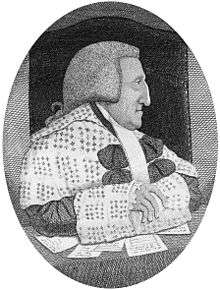David Rae, Lord Eskgrove
| Lord Eskgrove | |
|---|---|
 Lord Eskgrove | |
| Born | 1724 |
| Died | 1804 (aged 80) |
| Occupation | Scottish judge |
Sir David Rae, Lord Eskgrove, 1st Baronet FRSE (1724–1804) was a Scottish advocate and judge.
Life
He was the son of David Rae of St Andrews, an episcopalian minister, by his wife Agnes, daughter of Sir David Forbes of Newhall. He was educated at the grammar school of Haddington, and at the University of Edinburgh, where he attended the law lectures of John Erskine of Carnock.[1][2]
He was admitted a member of the Faculty of Advocates on 11 December 1751, and quickly acquired a practice. In 1753 he was retained in an appeal to the House of Lords, which brought him up to London, where he became acquainted with Lord Hardwicke and his son Charles Yorke. He was appointed one of the commissioners for collecting evidence in the Douglas case, and in that capacity accompanied James Burnett to France in September 1764. He was the leading advocate in the Scottish court of exchequer for many years.[1]
He became a Lord of Session on 14 November 1782, succeeding Alexander Boswell, Lord Auchinleck, and a Lord of Justiciary on 20 April 1785, taking the judicial title Lord Eskgrove (from a small estate which he possessed near Inveresk), in place of Robert Bruce of Kennet. Rae was one of the judges who tried William Brodie (died 1788) for robbing the General Excise Office in August 1788, the Rev. Thomas Fyshe Palmer for seditious practices in September 1793, William Skirving and Maurice Margarot for sedition in January 1794, Joseph Gerrald for sedition in March 1794, and Robert Watt and David Downie for high treason in September 1794.[1][3]
He was appointed Lord Justice Clerk on 1 June 1799, in place of Robert Macqueen, Lord Braxfield, holding office until his death. He was created a baronet on 27 June 1804. He died on 23 October the same year, and was interred in Inveresk Kirkyard.[1] He has a relatively modest stone on the south side of the church itself (St. Michael's) just to the left hand side of the south door. His wife and children are buried with him. This includes his son, Sir William Rae, 3rd Baronet, Lord Advocate of Scotland, here reduced to a simple name within a list on the stone.
Reputation
Rae is remembered by Lord Henry Cockburn in his book Memorials of His Time (published posthumously in 1856), as a “considerable lawyer” who became a deplorable judge, and Cockburn concludes “a more ludicrous personage could not exist.” [4]
| “ |
|
” |
Works
With John Campbell and others,[5][6] Rae collected the Decisions of the Court of Session from the end of the year 1756 to the end of the year 1760, Edinburgh, 1765.[1]
Family
He married, on 14 October 1761, Margaret (died 1770), youngest daughter of John Stuart of Blairhall, Perthshire, by whom he had two sons and one daughter:
- David, who succeeded as the second baronet, but died without male issue on 22 May 1815. David married Dame Helen Colt and had five daughters: Helen, Margaret, Mary and Grace and Eliza Colt Rae his youngest daughter who died at Edinburgh in 1872 (reference from the memorial stone)
- William (1769–1842) called to the bar in 1791, Office of Lord Advocate of Scotland from 1827 to 1830 (presiding judge at the trial of Burke & Hare on 24 December 1828 in Edinburgh); then M.P for Anstruther burghs between 1819 and 1826, then as M.P for Buteshire in 1830. Between 1831 and 1832 he was M.P for Portarlington, then returned to Buteshire as M.P. between 1833 and 1842. He died at St Catherine's House (Liberton, Edinburgh) in 1842. and
- Margaret, who married, on 3 January 1804, Captain Thomas Phipps Howard of the 23rd Light Dragoons.[1]
References
- 1 2 3 4 5 6
 "Rae, David". Dictionary of National Biography. London: Smith, Elder & Co. 1885–1900.
"Rae, David". Dictionary of National Biography. London: Smith, Elder & Co. 1885–1900. - ↑ Milne, Hugh M. (ed) (2001). Boswell's Edinburgh Journals 1767-1768. Mercat Press. p. 560. ISBN 1-84183-020-8.
- ↑ Milne, p561
- ↑ Cockburn, Memorials of His Time, cited in Milne, p. 561
- ↑ "Decisions of the Court of Session, from the end of the year 1756, to the end of the year 1760 [micro... | National Library of Australia". catalogue.nla.gov.au. Retrieved 2014-01-22.
- ↑ William Nairne, Lord Dunsinane, according to his DNB article
| Legal offices | ||
|---|---|---|
| Preceded by Robert Macqueen |
Lord Justice Clerk 1799–1804 |
Succeeded by Charles Hope |